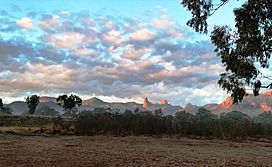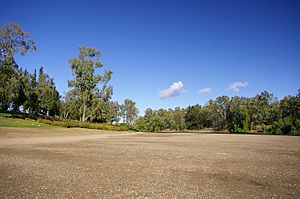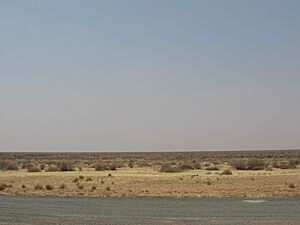Southeast Australia temperate savanna facts for kids
Quick facts for kids Southeast Australia temperate savanna |
|
|---|---|

|
|

Ecoregion territory (in purple)
|
|
| Ecology | |
| Realm | Australasian |
| Biome | temperate grasslands, savannas, and shrublands |
| Borders |
List
|
| Geography | |
| Area | 322,200 km2 (124,400 sq mi) |
| Country | Australia |
| States | Northern Territory and Western Australia |
| Conservation | |
| Conservation status | Critical/endangered |

The Southeast Australia temperate savanna is a huge natural area in central New South Wales, Australia. It's mostly grassland with lots of eucalyptus trees scattered around. This special ecoregion stretches from north to south across the state.
Contents
Where is the Southeast Australia Savanna?
This ecoregion is a dry place with gentle hills and valleys. The southern part is a flat area called the Riverina, which is famous for growing wheat. Further north, you'll find low hills and plains. These northern areas are mostly used for raising sheep.
The savanna reaches up to the plains of the Darling River basin and the border with Queensland. Important rivers like the Murray River and Murrumbidgee flow through the south. The Darling River is in the northern part.
It doesn't rain much here, usually between 300 and 500 mm (about 12-20 inches) each year. The further west you go, the less rain there is. The World Wide Fund for Nature (WWF) includes several areas in this ecoregion. These are the Darling Riverine Plains, Cobar Peneplain, and Riverina regions. It also includes the southern part of the Brigalow Belt in New South Wales.
Plants of the Savanna (Flora)

Because it's so dry, only tough plants can grow here. You'll see hardy shrubs and grasses. There are also small groups of bimble box and coolibah eucalyptus trees. These trees used to cover much more of this part of Australia.
Closer to the coast, in the Riverina area, you can find red river gum and black box trees.
When many sheep were brought to graze, it changed the grasslands a lot. The soil used to be soft and soaked up rain easily. But constant heavy grazing by animals damaged the land. This caused the native grasslands to change. Big, clumpy grasses like Themeda triandra (Kangaroo Grass) were replaced. Now, you often see grasses that can handle being disturbed, like Rytidosperma species.
Animals of the Savanna (Fauna)
This grassland is the western edge for many animals that live here. Beyond this area, it becomes a desert. Some of the cool mammals you might find include the mouse-like kultarr (a marsupial), the tiger quoll, and the brush-tailed rock-wallaby. Sadly, some animals that once lived here, like the western barred bandicoot and the bridled nail-tail wallaby, are now thought to be gone from New South Wales.
Many birds call this savanna home. These include the endangered bush stone-curlew, the beautiful superb parrot, and the rare red goshawk. You might also spot a malleefowl or a plains-wanderer. There's even an endangered skink reptile called Anomalopus mackayi.
The Riverina grasslands are especially important for birds. You can see freckled ducks there. In winter, swift parrots also come to this area.
Protecting the Savanna: Threats and Preservation
It's very important to actively protect these habitats. A lot of the savanna has been turned into farmland for crops or pastures for animals. This is especially true in the Riverina, where most of the land has been cleared for growing wheat. This clearing is still happening.
The grasslands are also at risk from too much grazing by animals. Rivers like the Murray and Murrumbidgee are used a lot for large irrigation projects. This means less water flows in the rivers. When land is cleared, it becomes a good place for new, unwanted species to move in. Examples include the noisy miner bird and the Australian raven.
Protected Areas in the Savanna
In 2017, experts looked at the protected areas in this ecoregion. They found about 15,778 square kilometers (about 6,092 square miles) were protected. This number does not include the Brigalow Belt south part of the ecoregion.
Some of the protected places in the Brigalow Belt part include parks and reserves in the Pilliga forest. Also, the steep, rocky hills of Warrumbungle National Park are protected. Other important protected areas are Barmah National Park, Gundabooka National Park, Murrumbidgee Valley National Park, Oolambeyan National Park, and Willandra National Park.
There are small protected areas in other places too. There are also plans to create more. However, there are no very large areas of the original savanna that are fully protected yet.
See also
 In Spanish: Sabana templada del sureste de Australia para niños
In Spanish: Sabana templada del sureste de Australia para niños

